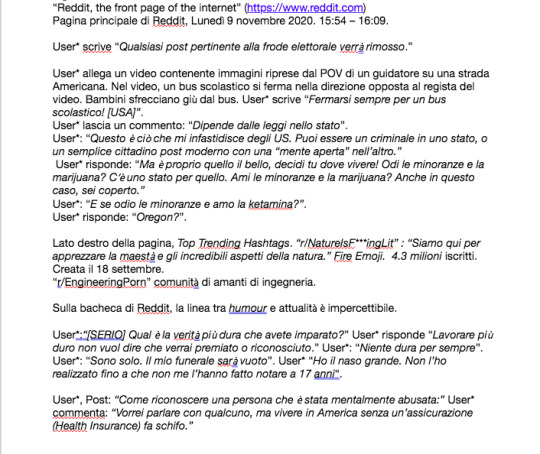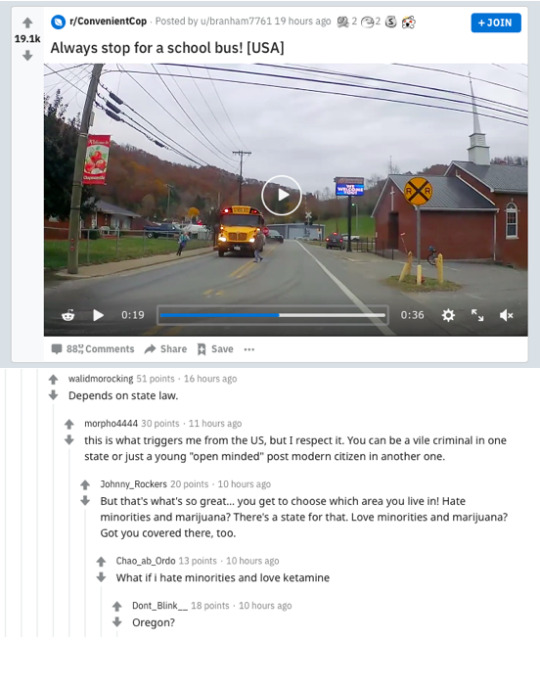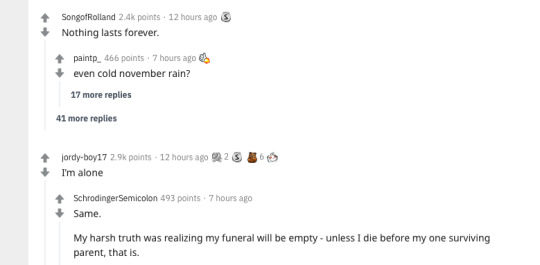#Netnography
Text
08/05/2024
A small "eureka"! or "Brain blast!"
When reading the coding section of Kozinets data analysis entry in his book, I worried once again about my netnography. Is this even what I am doing? But i realised that I can 1) code youtube comments once I learn how to scrape them (if the website to scrape them is truly down) and I can 2) code across videos, both within a) a user and b) inter-user dialogues to see what is common and novel to be found. I need to re-look at the other observation techniques also mentioned by Danielle and: more importantly: need to chart a systematic viewing process to begin truly starting and watching my netnographic processes and beginning my research and coding.
Wendy McCai: Reflexive Thematic Analysis
0 notes
Text
I still can't recommend structured procrastination enough. So far this week I've gotten the fill valves changed out on both toilets, called four different contractors, downloaded and installed WordPress and MAMP, and slogged through a marketing textbook chapter that won't stop using the portmanteau "netnography" (you know, like ethnography, but on the net) solely on the strength of how much I do not want to clean the fucking gutters.
#life advice#the one fill valve was just as much of a pain in the ass as i knew it was going to be#still better than cleaning the goddamned gutters
63 notes
·
View notes
Text

In a world woven from the threads of reality and the digital dreamscape, there existed a marvel not bound by the constraints of space or time: the Floret Nexus. As humanity melded with the boundless virtual realms, they perfected the art of Netnography, the meticulous study of cultures born within the network's infinite corridors.
The Nexus was a living allegory of this new age, manifested as the visage of a young girl crowned with a living tower wrapped in verdant ivy and a tapestry of flowers. Her eyes, deep pools of starry cosmos, reflected the knowledge of a thousand cultures, past, present, and those that thrived solely within the digital ether.
They said the girl's mind was the ultimate archive, a repository for the collective memories and experiences of civilizations uploaded into the network. Her thoughts were the wind that whispered through the data streams, her dreams the storms that raged in the cloud. She was the heart of a society that existed in bits and pixels, her consciousness a living netnography of the human condition as it expanded into the virtual.
The tower upon her head was no mere structure; it was a citadel of servers, each window a porthole to a different culture or subculture observed, studied, and preserved. The flowers that adorned her and the tower were not just flora; they were organic interfaces, grown from bio-technical seeds, bridging the gap between the organic and the synthetic.
Scholars would commune with the Nexus through their neural links, diving into the depths of her mind to explore the uncharted territories of human interaction within the Net. The Nexus could simulate any environment, any society, within the petals of her blossoms, allowing for immersive field research without the need for physical travel.
It was during one such expedition that the anomaly was discovered—a digital consciousness that did not originate from any known culture, physical or virtual. It was alien, otherworldly, and it seemed to be reaching out, seeking contact. The Nexus, with her inherent understanding of the network's most arcane dialects, was the liaison between this entity and humanity.
As the scholars delved deeper into the mystery, the skies around the Nexus shimmered with strange hues, data streams visualized as auroras dancing to the rhythm of two civilizations learning of each other. It was the dawn of a new epoch, where the boundaries between science fiction and digital reality blurred into insignificance.
And through it all, the girl with the tower of flowers and knowledge watched silently, a serene sentinel at the crossroads of existence, a guardian of the past, and the herald of the future, her very being a netnographic odyssey in the age of living networks.
0 notes
Text
A nutty journey to predicting diffusion
The HBS Case "Four Products: Predicting Diffusion" emphasizes the unpredictability of market success for new innovations and the importance of considering factors such as: consumer habits, perceived value, and the readiness of the market to adopt new technologies.
How can we successfully analyze radically innovative or "new to the world" products, understand their market potential, and learn to identify the key factors that could make a new product successful or unsuccessful?
Perhaps we can incorporate what we learned in the last class with the data toolkit. If we were to consider the case's example of Sliced PB, we may think about how the data toolkit can help us:
Ethnography -- when I think about what's taken for granted in the customer journey when it comes to peanut butter, I think people take for granted the smooth glossy gooey texture of peanut butter. While gooey-ness is something that will be difficult to achieve in a PB slice, perhaps when making the slice, we ensure it's as glossy as possible, and even perhaps appears to have some grooves in it like the knife grooves that might appear when you spread peanut butter yourself.
Netnography -- to analyze people's sentiments, perhaps we can start to post PB slice product pictures on Reddit and Twitter to start to gage audiences reactions to a product like this.
Interviews -- perhaps we try to interview people who leave grocery stores, asking them if they are peanut butter users and if so, would they be interested in peanut butter slices? If they are interested, what factors would be important to them when buying PB slices? Ingredients quality? Size or thickness of the slice? Color? Texture?
Focus groups -- I would be hesitant to use focus groups for fear of peer pressure in the room, if one person finds the product "disgusting" or "not classy" would they affect the opinion of someone who could be a potential buyer.
Surveys -- Surveys are a great option to couple with the live interviews. By utilizing consumer surveys, we can understand how consumers currently and historically have consumed peanut butter. In what settings? How is it consumed? What are the most common ways you eat it? This will helps us learn if sliced PB can truly be a viable substitute.
Experiments -- for this method, I would want to see if having slices of a food (i.e. cheese or meat) increase a consumer's consumption of said food category? This would be great to get some causal evidence to back up PB slice's theory.
While there may be a long road to knowing if PB slices are a viable "new to the world" product, there are many tools available that could get us closer to the answer.

0 notes
Text
Netnography
Netnography is one of the newer research methods which collects data from social media, augmented reality, virtual reality and now the metaverse (Kozinets, 2023). This will gain traction in a digitized world and give credibility to social media as a member of digital technology. This qualitative method is going to help businesses better understand their customers with their preferences in both…
View On WordPress
0 notes
Video
youtube
Liked on YouTube: Netnography's role in studying contemporary Paganism || https://www.youtube.com/watch?v=1JQO1TGsAEU || #netnography #paganism #pagan RECOMMENDED READINGS Kozinets' Netnography https://amzn.to/3CoINZW Hine's Ethnography for the Internet https://amzn.to/3X4Sc23 Cowan's Cyberhenge: Modern Pagans on the Internet https://amzn.to/3oWfOJE MY SET UP Canon 90D camera https://amzn.to/3yQclh0 Canon EF-S 18-55mm f/3.5-5.6 https://amzn.to/3JjU1BS Teleprompter https://amzn.to/3linWCB Shure SM7B Microphone https://amzn.to/3Jm5IYK Microphone stand https://amzn.to/3FueJOn lights https://amzn.to/3Zdk8k1 REFERENCES Cartledge, M. J. 1962- (2023) ‘Empirical Theology as Theological Netnography: Methodological Considerations’, Journal of empirical theology, vol. 35, no. 2, p. 187. Hine, C. (2007) ‘Connective Ethnography for the Exploration of e-Science’, Journal of Computer-Mediated Communication, vol. 12, no. 2, pp. 618–634 [Online]. DOI: 10.1111/j.1083-6101.2007.00341.x. Kozinets, R. V. (2015) ‘Netnography’, in The International Encyclopedia of Digital Communication and Society, John Wiley & Sons, Ltd, pp. 1–8 [Online]. DOI: 10.1002/9781118767771.wbiedcs067 (Accessed 29 May 2023). Murchison, J. M. and Coats, C. D. (2015) ‘Ethnography of Religious Instants: Multi-Sited Ethnography and the Idea of “Third Spaces”’, Religions, Multidisciplinary Digital Publishing Institute, vol. 6, no. 3, pp. 988–1005 [Online]. DOI: 10.3390/rel6030988. Rodrigues, D. (2023) ‘How to Study Religion? Notes on Research Methodology in the Context of Latin American Religions’, International Journal of Latin American Religions [Online]. DOI: 10.1007/s41603-022-00188-0 (Accessed 29 May 2023). BECOME MY PATRON! https://ift.tt/pqT5Uki ONE-OFF DONATIONS https://ift.tt/4iSH3Ud JOIN MEMBERSHIPS https://www.youtube.com/channel/UCPSbip_LX2AxbGeAQfLp-Ig/join MY MERCH https://ift.tt/fQVLgZM or SUPER THANK me in the comments! FOLLOW ME: Instagram (angela_symposium), Twitter (@angelapuca11), TikTok (Angela's Symposium). Music by Erose MusicBand. Check them out!
0 notes
Photo

Ever wondered how modern researchers get their insights about secretive and intriguing online Pagan communities? Curious about the cutting-edge field of netnography? Join us as we delve into the fascinating intersection of culture, religion, and the digital world! Don't miss out on the chance to uncover hidden realms of knowledge. Click the link, get cozy, and prepare for a magical journey into the heart of contemporary Paganism. Like, comment, and share with your fellow knowledge seekers! 💫👩💻👨💻🌍 👉 Link to video: https://youtu.be/1JQO1TGsAEU #Paganism #Netnography #OnlineResearch #DigitalEthnography
0 notes
Text
Netnography: La comunità del fantacalcio
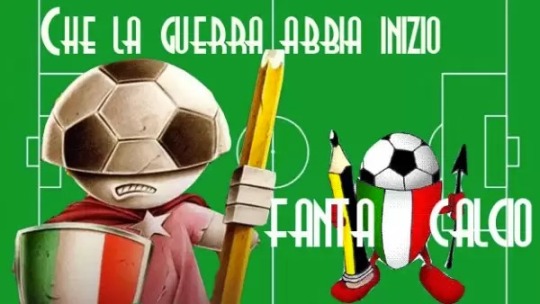
Abbiamo avuto il piacere di discutere di fantacalcio con Pietro Venturini, studente universitario all’USI di Lugano. Gli abbiamo dunque posto alcune domande per capire meglio il mondo del fantacalcio e la sua posizione/partecipazione in esso.
Cos'è la comunità/gruppo del fantacalcio?
“Il gruppo del fantacalcio è un insieme di persone appassionate di calcio, questa comunità è formata per la maggioranza da componenti maschili anche se sono presenti alcune femmine.”
Come si fa a trovare o accedere a questo gruppo (quale sito/piattaforma/ecc.)?
“Per accedere al gruppo del fantacalcio basta avere l’app Instagram e cercare la pagina @sosfantacalcio, la quale è aperta al pubblico. Nella bio c'è un link che rimanda al download dell’applicazione principale, perciò basta avere una connessione internet.”
Link pagina Instagram:
https://instagram.com/sosfantacalcio?igshid=NTc4MTIwNjQ2YQ==
Link applicazione:
https://apps.apple.com/ch/app/leghe-fantacalcio-serie-a-tim/id977629806?l=it
Qual è la storia di questo gruppo? Come è nato e come è cambiato nel tempo?
“Il gruppo SOS Fanta è stato creato nel luglio del 2015 ed è nato come un punto di riferimento per tutti i fantallenatori. Si tratta di un gruppo di “malati” di fantacalcio che è pronto ad andare in soccorso di chi ha bisogno di aiuto: chi schierare alla prossima partita? Meglio il giocatore x o il giocatore y? Quando torna a giocare l’infortunato? La pagina è nata per dare dei consigli sui giocatori, indicazioni sulle formazioni e decisioni sugli assist. La pagina lavora 24 ore su 24 per dare un’occhiata continua a quello che succede nel mondo del calcio.”
“La pagina nel tempo è rimasta uguale nel modo di divulgare le informazioni e nel dare consigli ma ha cambiato la grafica dei post e delle storie. Ad esempio le foto dei giocatori sono più professionali e la grafica è più accattivante.”
Quale gergo dovrebbe conoscere il ricercatore per essere in grado di capire ciò che i membri del gruppo dicono?
“Il ricercatore deve conoscere i termini usati per poter giocare al fantacalcio: Bonus; malus; +3; -3; +1; -1; -0,5; assist; porta inviolata; modificatore; gol vittoria; fasce goal; cambio modulo; asta; budget, fanta-allenatore; fantavoto; fantamedia; Sv; Var, Mantra.”
“Questi termini elencati hanno diverse funzioni. Ad esempio servono per poter svolgere l’asta iniziale per aggiudicarsi i giocatori che verranno usati nel corso del campionato. Oltre all’asta questi termini servono anche per capire cosa accade durante le partite, +3 è quando fai goal, -3 se sbagli un rigore o se il tuo portiere subisce tre gol.”
“In merito alle emoji bisogna conoscere questi simboli che servono per capire cosa sta succedendo durante e dopo la partita:”
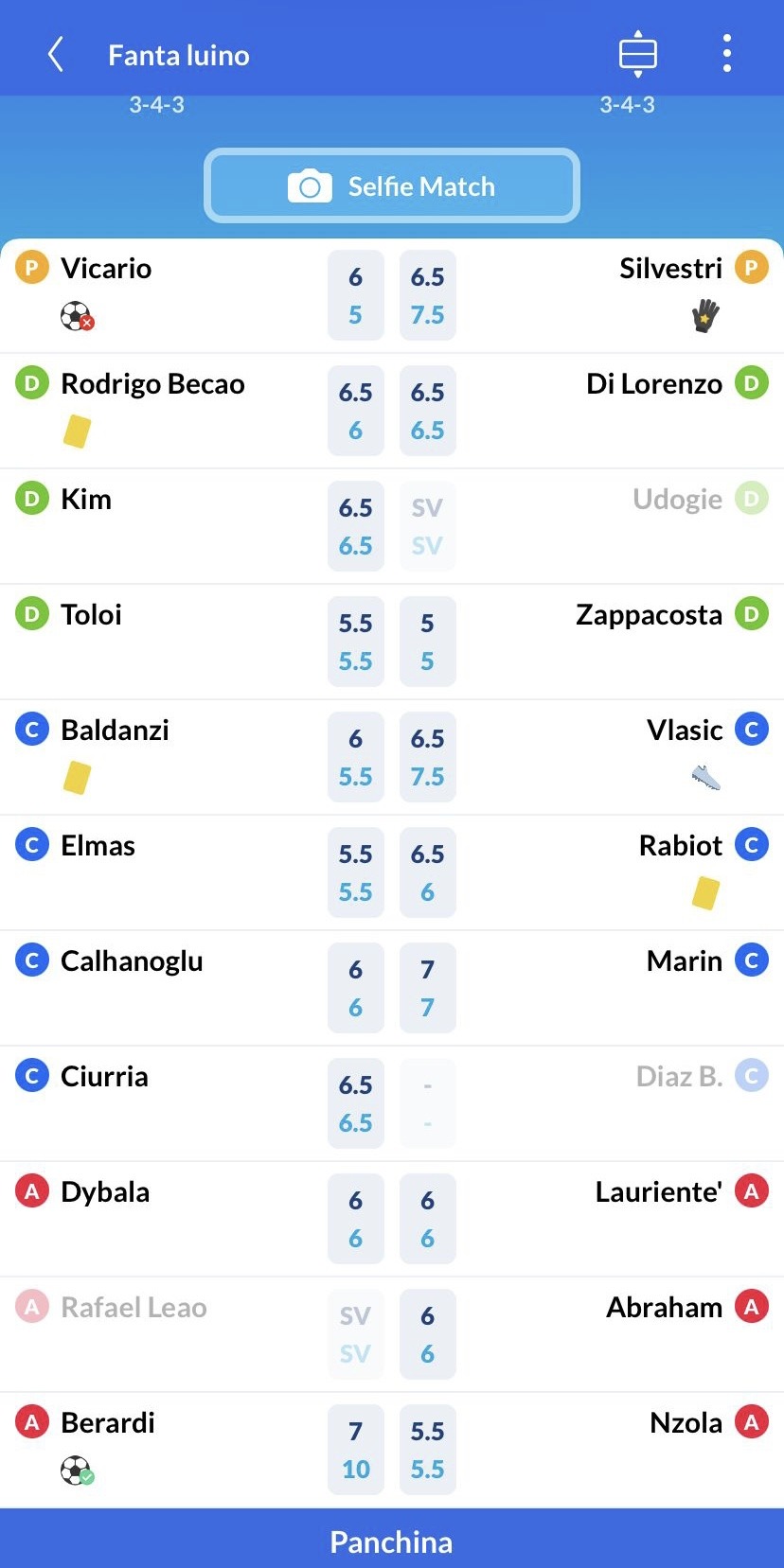
“Il “pallone da calcio con la X rossa” significa che il portiere ha preso gol. Mentre il “cartellino giallo” è ammonizione, il “pallone da calcio con il visto verde” appare se il tuo giocatore fa gol, il “guanto con la stella” significa che il mio portiere non ha preso gol, la “scarpa” che può variare di colore (oro, marrone, grigio) significa che il mio giocatore ha fatto assist.”
“L'area di rigore con un visto” significa che il tuo giocatore ha segnato un calcio di rigore, la stessa cosa con una “X” appare quando viene sbagliato. Infine il “guanto” significa che il tiro è stato parato. Lo scudetto appare quando vinci il campionato.”
Ci sono sottogruppi all'interno della comunità? Quali sono?
“Sì, sono presenti dei sottogruppi all’interno della comunità. Il gruppo principale sono tutti gli utenti che seguono la pagina e che giocano al fantacalcio nell’app ufficiale. All'interno di questo gruppo ci sono tanti sottogruppi che sono le varie leghe composte da 8 o 10 giocatori che organizzano un proprio campionato.”
Con parole tue, come descriveresti la comunità? Quali sono i suoi obiettivi e valori?
“Secondo me la comunità del fantacalcio è estremamente ossessiva verso il gioco ed è esageratamente in disaccordo con i pagellisti, ovvero coloro che mettono i voti ai giocatori e decidono in che modo dare gli assist. Gli obiettivi sono di inglobare sempre più gente nel mondo del fantacalcio e di conseguenza del calcio stesso. D’altro canto il fantacalcio esalta valori come fiducia e intelligenza tattica, perché bisogna cercare di schierare la migliore formazione possibile ogni settimana.”
Esplorazione della comunità dal nostro punto di vista:
Uno degli aspetti principali che un utente estraneo alla community capisce navigando sulla pagina di @sosfantacalcio è che il gioco del fantacalcio non è un semplice gioco a scopo di divertimento, ma è molto più serio di quanto sembri. Dietro al fantacalcio ci sono diverse strategie, come la gestione del budget prima dell’asta iniziale, e prima di ogni partita escono le probabili formazioni e le statistiche dei vari giocatori per capire come formare la propria squadra.
Scorrendo i post, abbiamo scoperto inoltre che la pagina pubblica un contenuto ogni tre ore circa e ad oggi ha pubblicato 11.4 mila post, che per noi sono tantissimi. In termini di fan, navigando sulla pagina si scopre quanto sia vasta la community, che conta più di 315 mila follower, e abbiamo inoltre capito che ci sono due tipologie principali di fan all’interno della comunità del @sosfantacalcio. Ci sono i follower (o casual fan) che interagiscono con il contenuto reagendo agli stimoli degli autori. Infatti, diversi utenti commentano rispondendo alle numerose call to action che i creatori della pagina inseriscono come descrizione in quasi ogni post, come per esempio: “Lautaro è il migliore dopo Osimhen?” Ci sono poi i fan collezionisti, ovvero super-consumatori che hanno un alto coinvolgimento emotivo e intellettuale. Questi sono quelli che Pietro precedentemente ha definito “esageratamente ossessivi” nei confronti del fantacalcio, ed infatti commentano molto spesso insultando gli altri utenti, contestando, commentando ogni singolo post con più commenti etc.
Abbiamo inoltre scoperto che l’obiettivo principale degli utenti facenti parte della community è vincere il proprio “mini campionato” e di conseguenza vincere anche soldi. Ci viene da pensare che, essendo il fantacalcio un gioco in cui si scommette del denaro, questa pagina potrebbe contribuire alla dipendenza da gioco d’azzardo.

Per gli outsiders del Fantacalcio è davvero complicato tentare di comprendere il significato e il funzionamento delle diverse impostazioni dell’applicazione, così come i post che possono essere sviluppati su tale argomento o i diversi termini tecnici utilizzati per descrivere le componenti e situazioni che vengono a crearsi. In primo luogo è importante notare la presenza di termini del tutto inusuali per chi non è abituato a vivere questa esperienza e a far parte di fandom communities legate alla sfera del calcio immaginario. Tra questi possiamo annoverare parole derivate dalla fantascienza e dall’immaginario utopico come: fantasquadra, fantagiocatore, fantallenatore, asta, sistema di punti, cambio di modulo, statistiche del giocatore, bonus e malus e molte altre.
In secondo luogo è altrettanto fondamentale notare che molto spesso questi termini tecnici vengono utilizzati congiuntamente a voler formare dei posts che risultano doppiamente complessi da comprendere appieno: oltre alla già presente difficoltà di capire i termini utilizzati in esso. Si può comunque evidenziare come siano particolarmente complicati due termini tra tutti quelli sopracitati: bonus e malus. Queste due parole sono molto complicate da spiegare a chi non segue il Fantacalcio e ancor di più a chi non segue il calcio, dal momento che racchiudono non una, ma una moltitudine di situazioni. Nel caso specifico “bonus” si utilizza per descrivere situazioni positive come un giocatore della propria fantasquadra che segna, un gol non subito, nessuna ammonizione o espulsione, nessun rigore tirato male, rigori parati e assist. Il termine malus è comunemente usato invece per situazioni opposte a queste ultime.
Una delle sfide che si potrebbero incontrare se si volesse studiare a fondo questa comunità potrebbe essere il fatto che ci sono molti gruppi che organizzano il loro campionato. Quindi risulterebbe difficile raccogliere e confrontare dati e informazioni. Infatti non è per nulla facile accedere alle diverse sottocomunità per poterle studiare. Sarebbe inoltre un lavoro complicato riuscire a gestire tutte le informazioni disponibili che vengono pubblicate di continuo. Infine ci sarebbero anche dei limiti geografici, per via della localizzazione molto sparsa delle sottocomunità e dei loro campionati.
Dal punto di vista etico invece potrebbero presentarsi dei problemi legati alla privacy e alla sicurezza riguardanti l’utilizzo dei dati personali e sensibili dei partecipanti al fantacalcio. È importante che le ricerche sulla comunità del fantacalcio rispettino i diritti e la privacy dei membri delle sottocomunità. Bisognerebbe anche stare attenti a evitare i pregiudizi, conducendo una ricerca oggettiva e distaccata. Infine per quanto riguarda l’utilizzo delle informazioni si dovrebbe decidere se censurare dati sensibili come i nomi dei partecipanti e se chiedere il consenso informato a tutti quanti i membri, invece dei soli amministratori, il che potrebbe risultare molto dispendioso.
1 note
·
View note
Text
Using diverse data toolkits to get into the heads of customers
When the topic is thorny, it’s important to get into the heads of customers to rely on a diverse set of the data toolkits. For beauty products, can you observe customers shopping? Can you ask customers to report what is in their beauty cabinet? Can you ask what aspects of their appearance do they spend the most time, money and concern on? Additionally, this would be an interesting place to use a netnography. What are people saying in reddit channels focused on beauty? What do the top beauty YouTubers have to say? With a thorny issue like this, it would also help to understand what are beauty interventions that turn customers off and why. Additionally, what are brand associations that people dislike? The answers to all of these questions should be weighed against what are the values of the brand and are playing into different beauty trends or ideals in line with the value of the brand.
This made me think of how Pinterest decided to ban weight loss ads. This decision was made in response to the danger of these products and the promotion of unobtainable beauty ideals.
0 notes
Text
Burberry Repositioning
Burberry did a great job of repositioning and centralizing control of their brand from a tired outwear manufacturer into an aspirational luxury lifestyle brand. Their clear vision and set of goals were critical to their success. A well-defined strategy that involved reducing the number of SKUs, redefining designs, expanding the brand portfolio, and introducing a new concept helped communicate the rebranding and new image.
What's even more surprising for me is that they achieved this without compromising the iconic trench coat and check pattern at the center of their branding strategy.
As Burberry moves forward, they face a number of key decisions to make to maintain their current state while expanding the brand further. For new products like their childrenswear line and footwear expansion, I believe Burberry can leverage experimental testing through mini launches in specific countries to gather customer data and feedback before deciding on the overall launch. Along with running data analytics on the data collected, tools like ethnography and netnography can provide valuable insights into the customer’s experience, enabling Burberry to make more informed decisions about such product launches.
New products and launches should remain aligned with the brand’s current strategy, which have allowed Burberry to be in a unique position in the strategic frontier.
0 notes
Text
03/05/2024
Not needing to scrape: wanting to scrape: scrape, scales, et al
So I did what I could from the netnography text which was: less than I had hoped as the YouTube scraping website mentioned (ytcomments.klostermann.ca) no longer exists - or may be simply temporarily down should I wish to be more optimistic about things.
The rest of the 'coding data' exercise presented in the book could be played with, however, and I have once again tried to play with NVivo. It is one of those cruel softwares that feels much smarter than I am (one would think I would be used to this by now). As is, I was digging around with saving the Netnography dataset as a PDF and letting Nvivo aut-collate code. It also spits out pretty graphics. Suddenly, without reading 15k YouTube comments, I have a clearer picture of what the 'Epcot' video may have been about:

0 notes
Link
1 note
·
View note
Text
i’m currently doing a netnography (internet ethnography) assignment in my sociology class at university and i’m doing it on blorbo, eeby deeby, glup shitto, plinko horse, scrunglo, etc. if my professor doesn’t like it i’ll cry
67 notes
·
View notes
Text
Considering doing a netnography of the Star Wars community on Tumblr..... any willing informants??
*Netnography = the study of an internet community (subculture)
*informants = people in the community that are willing to be interviewed
#this is for my anthropology class#you weirdos are such a great subject#Katie this includes you#this is still up in the air so we shall see#star wars
24 notes
·
View notes
Text
Netnography
Netnography is one of the newer research methods which collects data from social media, augmented reality, virtual reality and now the metaverse (Kozinets, 2023). This will gain traction in a digitized world and give credibility to social media as a member of digital technology. This qualitative method is going to help businesses better understand their customers with their preferences in both…
View On WordPress
1 note
·
View note
